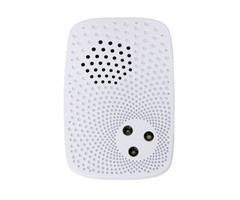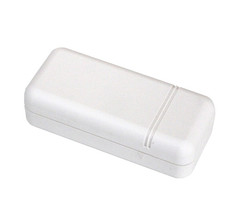Product Highlight: 2GIG RPTR1-345
Posted By Michael GorisHi DIYers! Today, we're taking a look at the 2GIG RPTR1-345. This is a wireless repeater that takes the signal sent out from 2GIG 345 MHz Sensors and repeats them out a second time. This will effectively double their range. The device also works with the Honeywell 5800 Series Sensors.

Wireless sensors work by sending radio frequency signals to an alarm control panel. However, these signals cannot travel an infinite distance. If a user is experiencing range issues, then they might add a wireless repeater to overcome the problem. A wireless repeater will take the signal sent out from the sensor and send it out a second time. By doing this, the sensor's range will be doubled.
In order for a wireless repeater to work, it must recognize the signal transmission that the sensor is putting out. The 2GIG RPTR1-345 effectively works the same as the wireless receiver housed inside the 2GIG GC2 and 2GIG GC3 Systems. The panel's receiver also accepts signals from Honeywell 5800 Sensors, and the 2GIG RPTR1-345 will also effectively repeat these signals. This makes it perfect for anyone with legacy Honeywell/2GIG Sensors who wants to increase wireless signal range.
Most 2GIG 345 MHz Sensors have a wireless range of 350 feet in open air. However, this range can be reduced due to large metal objects and other obstacles. Mounting a sensor on a metal door or structure could also interfere with the range. Also keep in mind that some recessed sensors like 2GIG DW20R might have a shorter range than other 2GIG Sensors. But adding a 2GIG RPTR1-345 may be able to help you overcome the problem.
If the signal from a 2GIG 345 MHz Sensor travels 350 feet to the repeater, the repeater will take that same signal and send it out an additional 350 feet. This will give the sensor a maximum range of 700 nominal feet. This can be the perfect solution for anyone suffering from range issues. The repeater will even work with the Qolsys IQ Panel 2 Plus with Legacy 345 MHz Daughtercard, as it can repeat the signal for any legacy 345 MHz sensors used with the system.
The 2GIG RPTR1-345 is a plug-and-play device, meaning that it will start repeating signals as soon as it is plugged into a wall outlet. You don't need to program it to the panel for it to work. However, you can still program it to a wireless zone for supervision purposes. This is completely optional, but it can be smart if you have several wireless zones available. Please note that while a plug-in transformer is included, no wiring is provided. You can use a Honeywell LT-Cable to making wiring as easy as possible.
In addition to the 2GIG RPTR1-345, Alarm Grid also offers the other wireless repeater modules:
- DSC PG9920 - for PowerG 915 MHz Sensors.
- DSC WS4920 - for DSC 433 MHz Sensors.
- Honeywell 5800RP - for Honeywell 5800 Series Sensors only.
- Interlogix-80-922-1 - for Qolsys and Interlogix 319.5 MHz Sensors.
Please note that there is currently no repeater available for Honeywell SiX Series Sensors. We hope that will change in the near future, as there are many user who would like to increase the range of their SiX Devices. We will let you know if such a module ever emerges.
You can extend the signal range of your 2GIG Sensors with the 2GIG RPTR1-345 wireless repeater. Get yours today!

































